It’s been a week of 25th anniversaries. 1987 was a great year. Final Fantasy, Mega Man, The IROC-Z Camaro, the list goes on. On the humble Sega Mark III, known as the Sega Master System in the West, 25 years ago we also saw the birth of another great RPG series. The Phantasy Star series. While the series today isn’t in the same form it once was, it’s still something I have a deep appreciation for. There’s very few games that I will say define me as a gamer, and Phantasy Star is one of them. The series is still alive and kicking on the PC and PlayStation Vita with Phantasy Star Online 2. While the newer games aren’t necessarily canonically connected to the original four games, there’s plenty of references and themes that echo through. It may not be Algol, but it’s definitely Phantasy Star. While the series has gone everywhere from text adventure to an online multiplayer hack and slash, it all started as an 8-bit RPG with 3D dungeons.
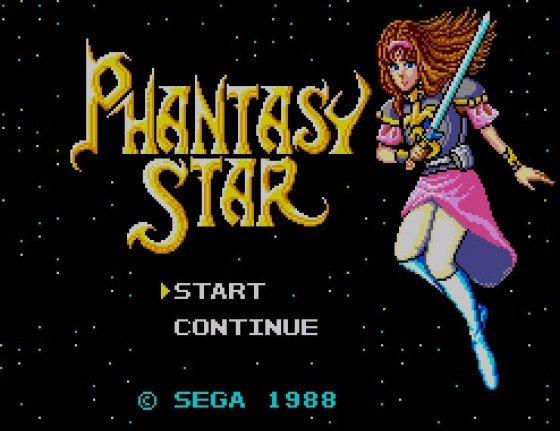
Meet Alis, the pioneer of female RPG leads.
Phantasy Star takes a page out of Greek mythology and also tosses sci-fi elements into the mix. There’s some inspirations from Dune in there, too. You guessed it, you’ll be fighting medusas, sand worms and robots in addition to dragons, slimes, and skeletons. you take the role of Alis, who sets out on a quest to overthrow King Lassic after her brother Nero was slain. Along the way you get to meet a talking “Musk cat” named Myau, a mighty warrior named Odin and the Esper Noah (Lutz in the Japanese version). Along the way you travel between the three planets in the Algol solar system on her quest to overthrow Lassic. The original Sega Master System version stood the test of time fairly well. It was a marvel in it’s time, with it’s 3D dungeons, the large images it uses for storytelling, and unique setting.
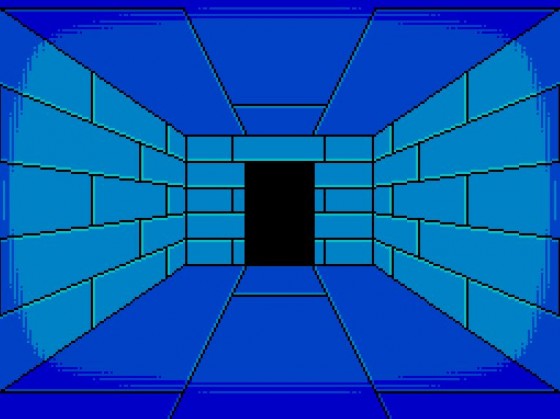
The 3D dungeons really showed off the power of the Sega Master System.
I find it every bit as fun to play now, as I did when I first played it, even if it does seem a bit grindy. The biggest challenges lie in the dungeons more than anything. You’re going to want some graph paper for this one. The battle system is simple, but it’s on par with everything else from the same time period. It’s your standard turn based combat, where you square off against a single enemy, sometimes multiples of the same type of enemy.
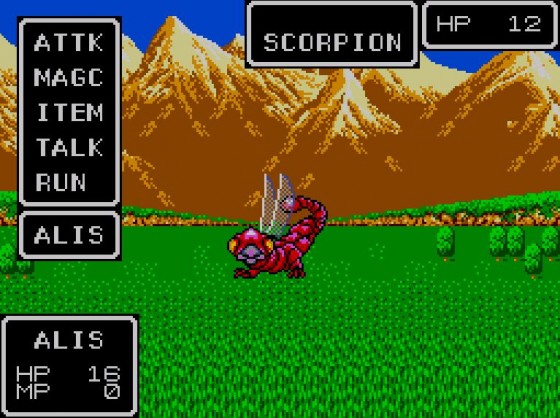
Yep, you get to fight winged scorpions! There’s owl bears, too.
Looking back, the storyline is a bit simple compared to modern RPGs, but it’s still very charming. It also set the stage for many more games to come. A remake was released in 2003 for the PlayStation 2. Phantasy Star Generation: 1 was released as the debut title of SEGA’s 3D Ages series. It gave a facelift to the original game, but left the formula mostly the same, including town and dungeon layout. They added in some annoying fetch quests that forced certain interactions before you could continue with the plot, even if the next thing to do was already clearly spelled out for you. It was a little frustrating, especially if your Japanese isn’t the best. The battle system’s been streamlined and the design reminds me a lot of what Phantasy Star 4 would have if it were 32-bit. You get to fight different types of enemies at once now, which is a welcome addition.
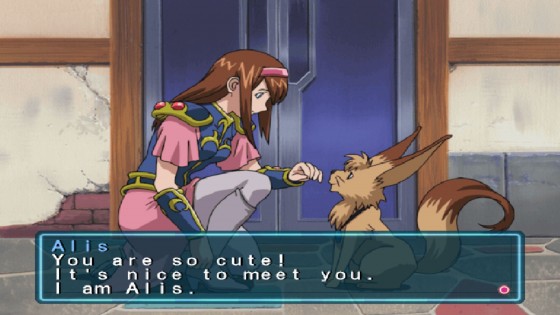
Even though the art style is different, the remake has some nice artwork.
While the graphics do look pretty nice, you might look at the remake and guess it to be a bit older than 2003. I’d say It has a 1996 feel to it, and could easily have been an early Saturn or PlayStation game. The music is the most disappointing factor of the remake. The original had amazing music and there’s no end of awesome remixes floating around that could easily have made their way into the game. What we got was very generic sounding, and not very high quality. There was a planned US release of the remake, but it got delayed to oblivion. Fans of the series have taken the job into their own hands, though and you can check it out in English if you know the right channels.
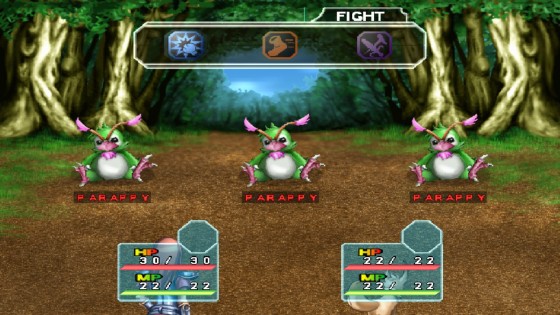
Rappies weren’t present in the original but the remake sought out to fix that.
Phantasy Star captured my heart, and the Eclipse Torch has been passed. For my Son’s third birthday, I bought him a Game Boy Advance and a number of games for it. One of the games was Phantasy Star Collection. I didn’t expect it to happen, but that’s what’s been in his Game Boy the most since he’s gotten it. He hasn’t made much progress since he can’t read yet, but he’s gained a few levels, and almost gotten Myau. I forsee it being one of those games that we play through together in about a year or so.
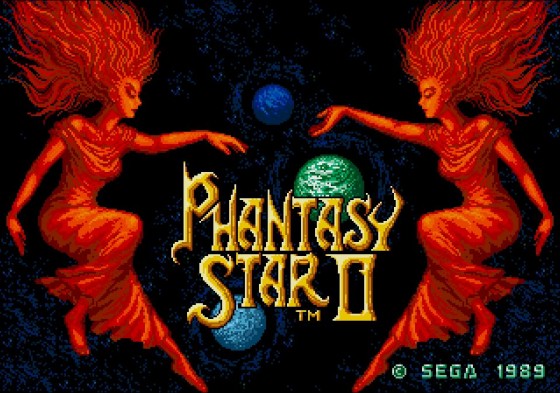
We return to Algo for another epic adventure in Phantasy Star II!
And of course, the series doesn’t stop there. In 1989 Phantasy Star II graced the Genesis. It’s a bit different than the original. There’s no more Greek mythology references, but a lot more sci-fi. The 3D dungeons are nixed with the more traditional overhead view seen in other RPGs at the time. The battle system was expanded upon but it’s not very user friendly. It’s set up mainly for auto-battle, but you can set specific commands. Phantasy Star II also introduced the iconic character Nei thus introducing Numans (or Newmans) to the series.

Exploring the icy depths of Dezoris. If you ask me, I think they’re under-dressed.
Despite the new view for dungeons, Phantasy Star II was more mazelike than the original. I don’t think it’s possible to beat it without pen and paper to keep track of where you are. It seemed common for Genesis RPGs to ship with a strategy guide, but it still was brutal. Beating Phantasy Star II was one of my prouder moments as a gamer, and the ending was unexpected but worth it. You have to want to beat it, and it’s worth it.
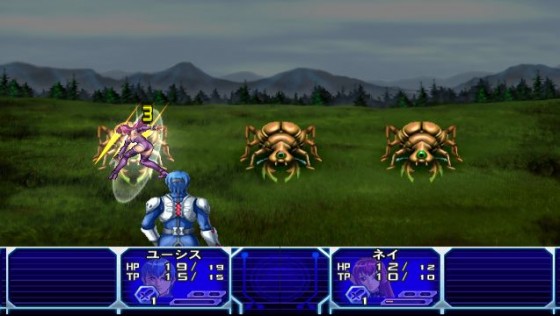
New battle backgrounds are a welcome addition. You can use the old grid, too.
Also released as part of the Sega Ages 2500 series, dropping the whole 3D Ages thing, was Phantasy Star Generation: 2. Again, a US release was planned, but didn’t make it to store shelves. It’s a bit higher quality than the remake of the first, and doesn’t feel the need to toss in needless interactions to force the story along. They also made the battle system a bit more straightforward and added different strengths of attacks. As a special treat to fans, if you have a save file from completing the first game and loaded it into the second it gave you the ability to save a certain someone.
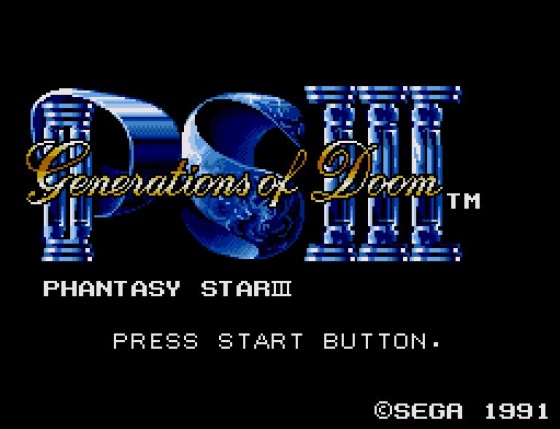
The traditional logo is replaced with pillars. It’s a testament to how different the game is.
Phantasy Star III: Generations of Doom is often considered the black sheep of the series, as it’s quite a departure from the rest of the games. Instead of being set in Algol, it’s set in a more traditional medieval setting. Although there’s still androids present, so there’s some sci-fi elements. Instead of one continuous plot through the whole game, you go through three generations. You complete a scenario, then choose who you wish to marry, then play as your child through another scenario. It added a bit of replayability, which was nice, because I felt the game to be on the short side.

More instruments were added to the music on the map with each new party member.
It wasn’t quite what people expected and most people consider it to the the weakest of the series. The enemy design was off the wall, and the combat system was just plain strange, but at least it introduced rappies. It’s probably the easiest of the main series, too. The dungeons are less labyrinthine than Phantasy Star II, and generally none of the bosses seemed that threatening until the end. All in all, I did find it to be an enjoyable game and it’s certainly worth checking out.
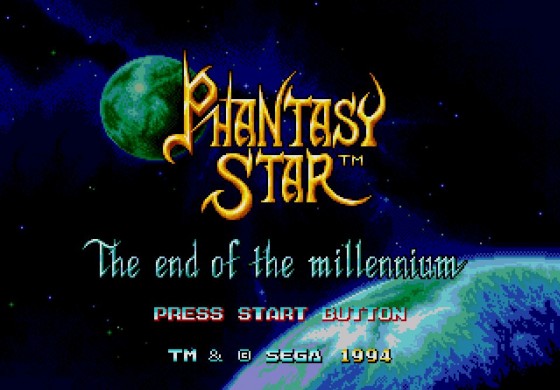
With a price of around $99.99, it was also one of the more expensive Genesis games.
Phantasy Star IV landed itself on the Genesis in early 1995, more than a year after the Japanese release. It was worth the wait. Not only is it considered the best game in the main Phantasy Star series, but one of the greatest 16-bit RPGs. The story comes back to Algol, and introduces some of the more memorable characters in the series, such as Rune, Rika, and Chaz. It also marks the first time a native Motavian and Dezorian join the party. While it pays homage to Phantasy Star I and II, it does stand on it’s own fairly well if you’ve never played them, although it’s a much richer experience if you have. You’re going to recognize many towns, dungeons and music from the first game.
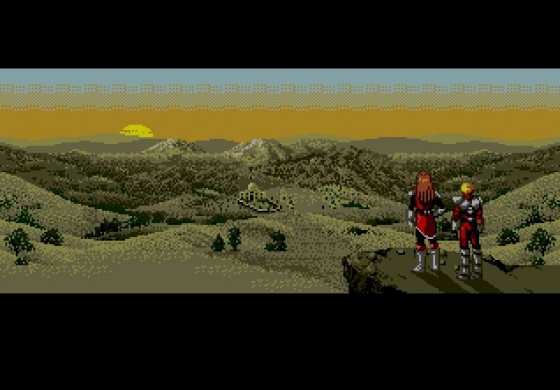
Alys and Chaz gaze out upon the vast deserts of Motavia.
If you play any Phantasy Star game, I suggest you at least play IV. While the others were great, Phantasy Star IV really outclasses them in terms of story, music, character development, and playability. A remake was planned as part of the Sega Ages series as well, but it ended up in development limbo, and was scrapped when Phantasy Star Complete Collection was released for PlayStation 2. I would have loved to see it, and hope someday it happens. Phantasy Star IV not only marked the end of the main series, but the end of the series being presented as a traditional RPG. The future of the series would be whole new world.
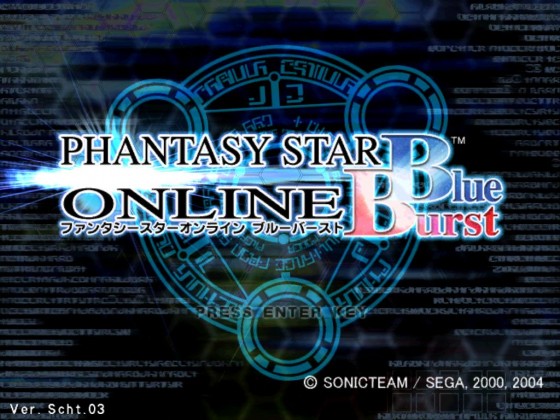
Blue Burst is the latest version of the original Phantasy Star Online.
After nearly a decade of laying dormant, the series would be resurrected on Dreamcast as the revolutionary Phantasy Star Online, developed by Sonic Team. It came out in early 2001 and was one of the first console games that could be played online with multiple people. Set far away from the Algol system and taking place on Ragol, you set out to solve the mystery behind the explosion of the Central Dome. The story of the game is told mostly through quests and messages left behind by Red Ring Rico. The real fun begins when you take the game online and play through the game with three of your friends, or random people you meet from all over the world.
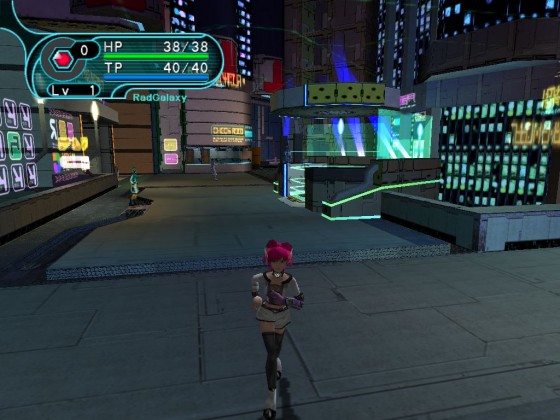
I could really use some friends on this adventure.
The original game featured four distinct areas to explore, through three difficulties. Although it sounds small in concept, it was a very addictive formula that you could play for many hours on end trying to collect rare weapons, reach the level cap, and find all of the secrets. Later a Phantasy Star Online Version 2 would be released for Dreamcast and PC which added a 4th difficulty, new rare items, and another 100 levels to gain and some opportunities to battle against your buddies.
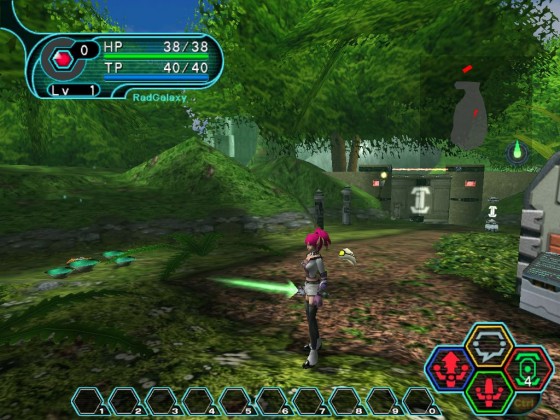
Surely anything I fight here won’t be a match for my bottom rung saber!
In 2002, Phantasy Star Online would be expanded on once again, this time on the Nintendo GameCube and the Microsoft Xbox with Phantasy Star Online Episodes: I & II. It encompassed the entire game from Dreamcast including the upgrades from Version 2, added three new types of characters to play as, and another four new areas, nearly doubling the game play length. The Xbox version took advantage of the Xbox Live features and included voice chat.
Phantasy Star Online: Episode III: C.A.R.D Revolution was released in 2003 exclusively for GameCube. It’s a vast departure from the rest of the online series, with battles taking place with, you guessed it, cards. While it had interesting strategy based gameplay, it wasn’t quite what the fans were looking for, and is often forgotten. The music, must like the rest of the online series, was fantastic and I wish more people played the game so they could enjoy it.
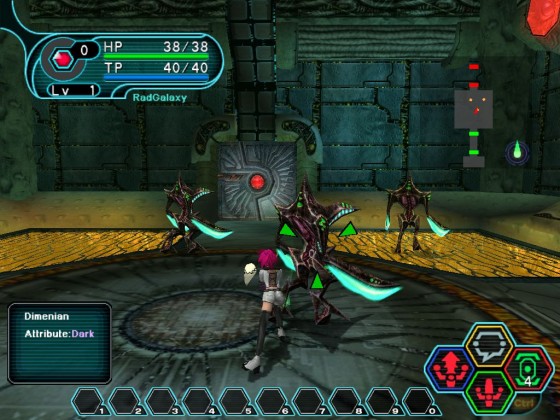
I think I need to grind out a few levels before fighting these guys.
A PC port of Episodes I and II would show up a few years later, now titled Phantasy Star Online: Blue Burst, making some minor balancing changes and this time having online-only play, which was a point of contention among fans. Blue Burst received continual updates, bringing out new items and content and eventually Episode IV. The online system laid the groundwork for the next game in the series.
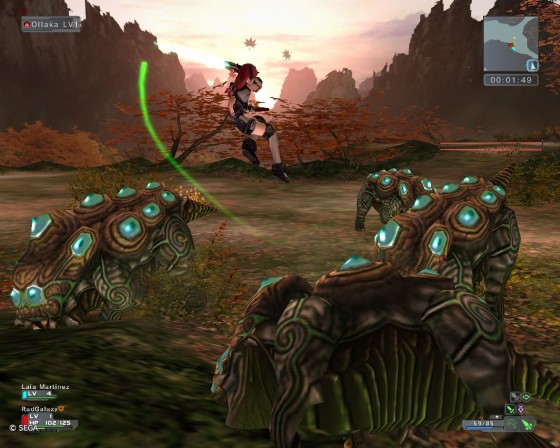
Hooray for photon arts in Phantasy Star Universe! I’m going to wreck these guys!
Phantasy Star Universe showed up on Xbox 360, PC, and PlayStation 2 in 2006. Offline play returns in the form of a unique storyline where you play the role of Ethan Waber, while online play lets you create your own hero and explore the Gurhal Star System. Echoing the original game series, you explore Moatoob, Neudaiz, and Parum. I give it a lot of credit for feeling like a very large game, despite not being a true MMORPG. It did have it’s problems, such as having your weapons destroyed if you attempted to grind them and failed and a strange weapon synthesis system. A lot of fans also balked at the heavy anime influence of the character designs and the addition of the beast race. The world would be expanded upon with the expansion pack Ambition of the Illuminus, and three titles on PSP: Phantasy Star Portable, Phantasy Star Portable 2, and Phantasy Star Portable 2 Infinity. I invested a lot of hours into PSU and part of me misses it a lot since the console and PC versions have been taken offline.

Phantasy Star Zero uses the same formula as the original PSO with some upgrades from PSU
Occurring in it’s own world is Phantasy Star Zero for Nintendo DS which reverted to a formula more like the original Phantasy Star Online. To simplify chat functions online, it used a system similar to Pictochat. The character designs are done by Toshiyuki Kubooka, of Lunar fame, and have a bit of a wild west look to them. They come across as a lot more cartoony than other Phantasy Star games, but Phantasy Star Zero is aimed at a younger audience, so it works out.
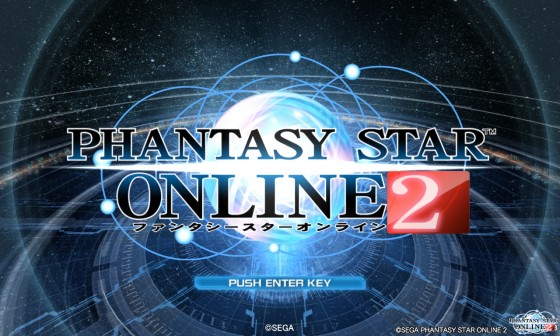
PSO2 is just getting revved up in Japan and will be debuting soon in the US and Europe.
Of course, that leaves the newest game in the series, launching in the summer of 2012 in Japan, and sometime in 2013 in the US is Phantasy Star Online 2. PSO2 uses an interesting subscription model. The game itself is free, and you don’t need to pay anything to play it online if you don’t want to. However, you’d be missing out on a lot of features, such as your own personal room, the ability to sell items on the player shops and the ability to trade items. There’s also microtransactions where you can buy scratch tickets for new costumes and accessories for your characters.

PSO2 has some enormous bosses, and throws in more almost every month.
The gameplay’s been updated since Phantasy Star Online and Universe. Photon Arts from PSU return, but you find certain leveled discs, like techs in PSO. Multiplayer capabilities are also expanded upon, adding areas where up to 12 players can participate. The game receives a constant stream of updates, introducing new items, bosses, areas and features once a month or so. While it’s currently only available for PC, a PlayStation Vita version will be released in Japan in 2013.
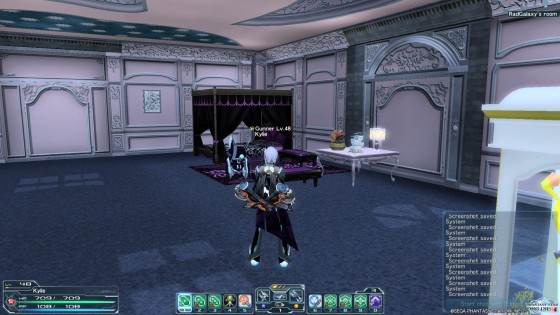
“My Rooms” are just one of the features you have to pay for to access.
That covers the main games of the series. There’s been a few other games throughout the years. For GameGear we had Phantasy Star Adventure, which was a text adventure. While not released outside of Japan, just like Gaiden, it did receive a fan translation. The main music, for some reason, is one of my favorite pieces in the series. I don’t know why, it’s just so happy, and fun. Phantasy Star Gaiden for Game Gear tried to fill in the gap between the first two games, but I don’t think it’s considered canon, and it was rather odd. Sega CD saw a few other text adventure games as well, featuring characters from Phantasy Star II. Android and iOS are going to get Phantasy Star Online 2 ES.
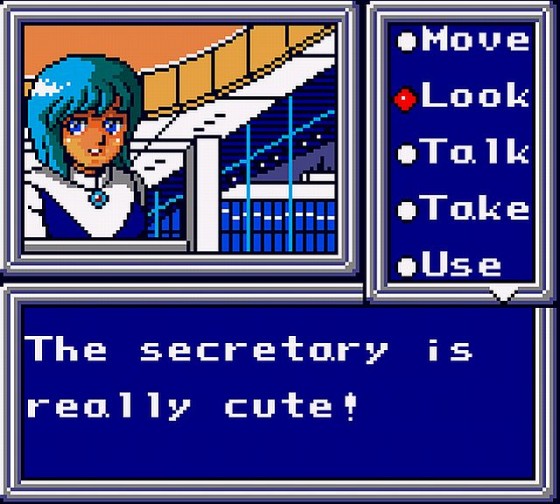
Although it’s two hours long at best, Phantasy Star Adventure was a lot of fun.
A fair number of compilations have shown up as well. Phantasy Star Collection on Saturn contained the original four games, while on Game Boy Advance it contained only the first three. Phantasy Star Complete Collection for PlayStation 2 and currently available on PSN had all four of the main games, the text adventures from Sega CD, and Phantasy Star Gaiden. Even though it was released only in Japan, it also had English versions of the first four games. Sonic’s Ultimate Sega Genesis Collection for PlayStation 3 and Xbox 360 has all four of the original games as well. There’s been countless other re-releases, too many to cover point by point.
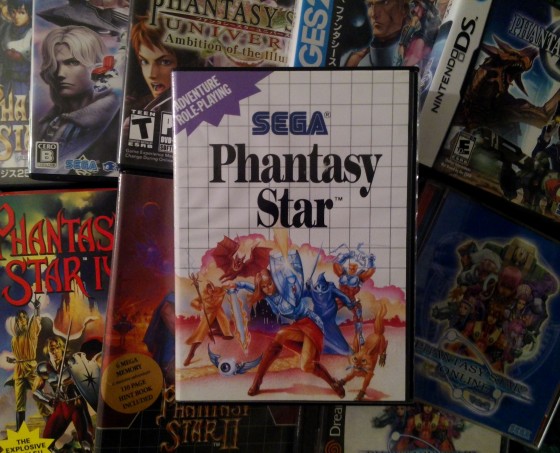
It’s an impressive series that’s certainly evolved through the years.
Phantasy Star has been an RPG staple since it’s inception, and it continues to be. 25 years later, it may not quite be the same thing it once was but there’s still remnants from the original games littered about. SEGA obviously hasn’t forgotten the roots of the series either, as the logo to the 25th anniversary concert prominently shows Myau and is written in the original font. While I’d love to see a Phantasy Star 5, or at least a return to Algol, Phantasy Star Online 2 is a great experience, and has been fairly successful so far. So, here’s to you, Phantasy Star! I’m looking forward to the many more years we have together!
Have some Phantasy Star stories of your own? Comment below, or drop me a line on Facebook or Twitter!


